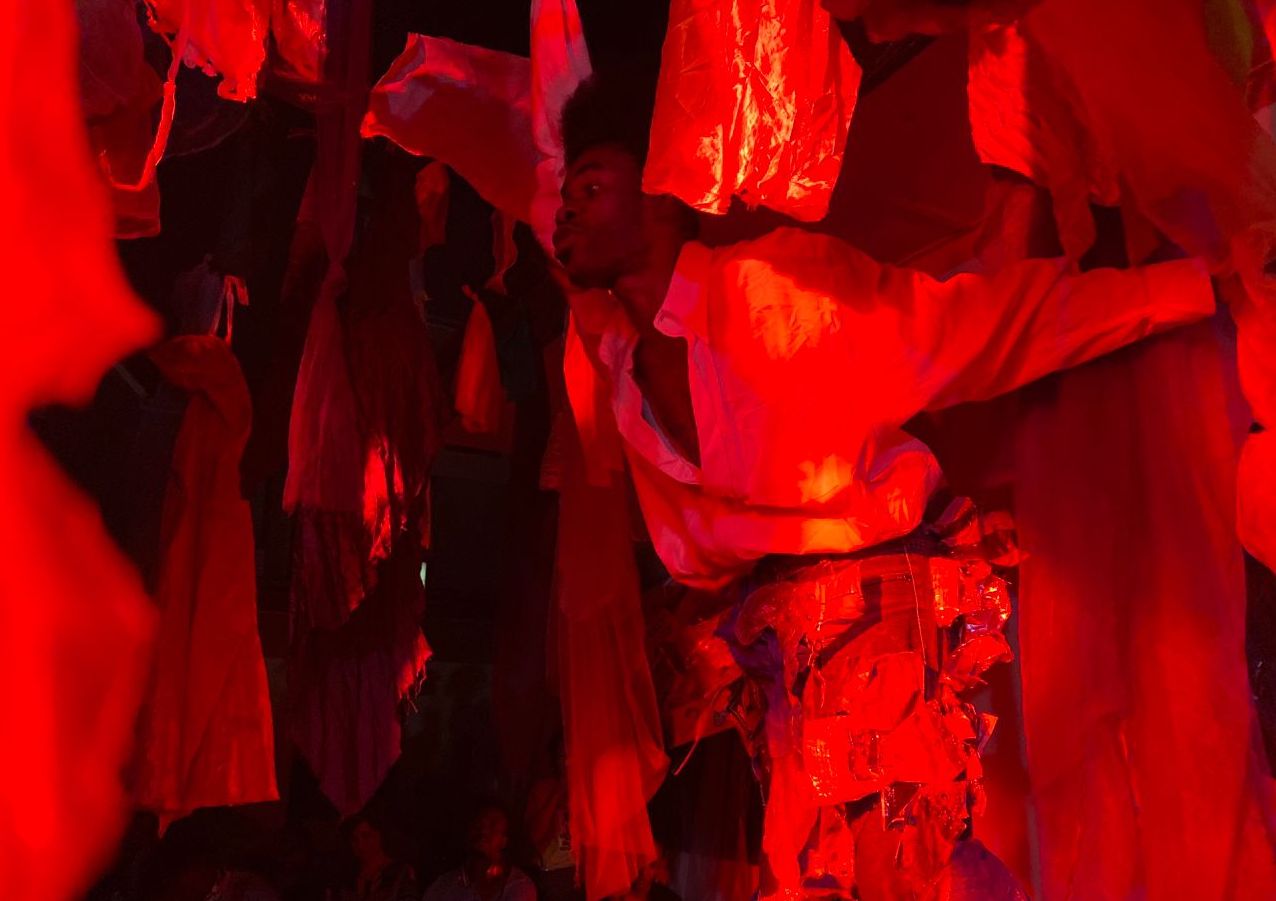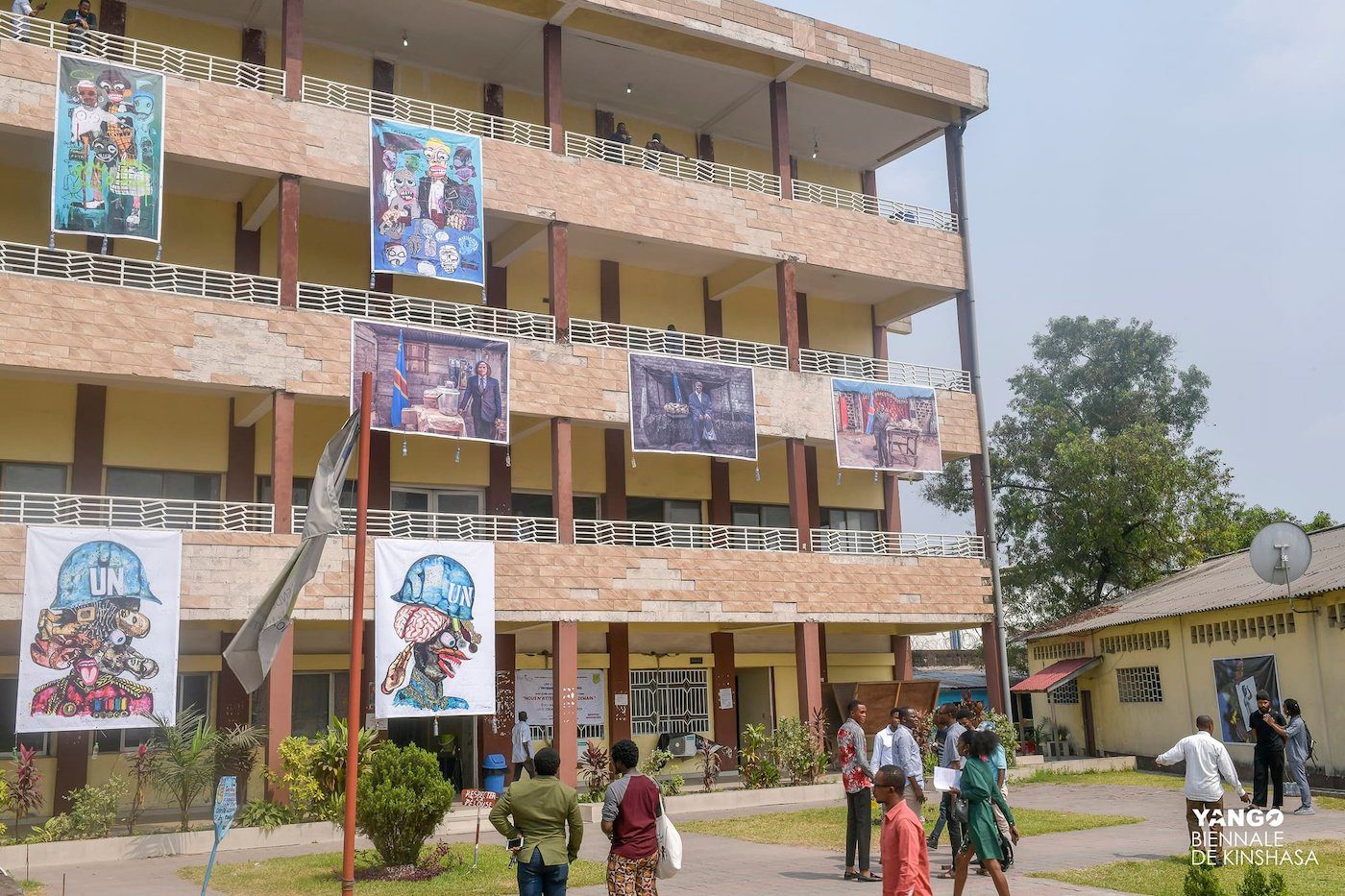Costa Tshinzam, auteur chez C&, a visité la deuxième édition d'une biennale très attendue qui a réussi à se replacer sur la carte mondiale des événements artistiques.

Performance by Azazou Show. Photo: Costa Tshinzam
La 2ème édition de Yango Biennale de Kinshasa s’étend à travers la capitale de la République démocratique du Congo du 13 juillet au 14 août 2022. Elle ambitionne de s’imposer comme une « Biennale protéiforme, processuelle, capable de s’affirmer comme force sociale », selon la note d’intention écrite par Nadia Yala Kisukidi et Sara Alonzo Gomez, commissaires en charge de la direction artistique de ce festival d’art contemporain. Un questionnement depuis Kinshasa, sur la pertinence même de faire de l’art en Afrique, dans un monde bouleversé par des conflits en tout genre.
La ville province de Kinshasa, reconnue comme un vivier d’artistes de talent, fait office de principal lieu d’expositions, de performances, de spectacles et d’échanges sous forme d’ateliers et de conférences entre artistes, chercheur·es, théoricien·nes et professionnel·les. La biennale se déploie à travers vingt sites choisis sur les vingt-quatre communes qui composent l’ancienne Léopoldville. Dans ce festival pensé par le photographe Kiripi Katembo Siku disparu inopinément en 2015, se croisent des artistes contemporain·es du Congo et de sa diaspora, mais aussi d’ailleurs à l’instar de Claudia Tennant (Afrique du Sud), Laeila Adjovi (Bénin) ou Azazou Show (Cameroun).

Installation View of the exhibition at l’Université Libre de Kinshasa. Photo: Yango Biennale de Kinshasa
Avec plus de vingt sites (ré)aménagés en lieux d’exposition, Kinshasa, plus grande ville de la République démocratique du Congo et d’Afrique, également plus grande agglomération francophone du monde depuis 2010, a accueilli plus de trente artistes pour rayonner et faire rayonner « Kinshasa-la-Belle » au travers de leur créativité. Pour que l’art investisse la ville, l’organisation ne s’est pas empêchée d’utiliser les panneaux publicitaires et les murs de différents espaces publics comme support d’exposition. Le site internet de la biennale et les réseaux sociaux sont aussi venus à la rescousse de l’événement, pour la présentation au travers de très courtes vidéos consacrées à trente artistes invité·es, et leurs créations respectives, perceptions et conceptions du ou des mondes qui les entourent.
Les sessions d’ateliers organisées en amont ont permis aux artistes de saisir le « présent » kinois où les « cartes se déplacent, se transforment et produisent de nouvelles images, des textes inédits, que plasticiens, musiciens, écrivains, slameurs, vidéastes, photographes contribuent à recomposer » avec en toile de fond : « Nous n’attendrons pas demain » !
Il faut néanmoins noter que cette Biennale a essuyé des moments difficiles qui pourraient expliquer un si long « intervalle intergénésique » entre l’organisation de la première et la deuxième édition d’un festival d’art contemporain qui accouche péniblement de sa progéniture. Avec en 2015 le décès brutal de Kiripi Katembo Siku, visionnaire de l’événement et, la crise liée à la pandémie du nouveau coronavirus qui, depuis sa déclaration en Chine en 2020, bouleverse le monde, imposant ainsi plusieurs reports de l’édition en cours. Un défi que semble, aujourd’hui, relevé par Nadia Yala Kisukidi et Sara Alonzo Gomez, curatrices, soucieuses de replacer cette messe de l’art contemporain sur la carte mondiale des événements artistiques.
Le choix des artistes n’est pas anodin. S’il permet la création et le maintien d’un fort réseau d’échanges d’expériences entre artistes reconnu·es et celles·ux dont la visibilité commence à s’établir, du nord comme du sud à partir du « Marché au sel » , il répond surtout à l’objectif de départ fixé par l’initiateur de cette Biennale : « Permettre un cadre de professionnalisation, connexion au monde et ancrage dans l’espace urbain qu’ils [les artistes] interrogent dans leurs créations ». Vendredi 15 juillet 2022. 15 heures. Rond-point Kabambare de Barumbu : l’artiste suisse Aurélien Gamboni qui mène une pratique d’investigation, a réalisé, selon ses habitudes, une enquête de terrain qu’il a déployé ensuite sous forme de performance artistique collective dénommée « COOP. Kin » en collaboration avec les Congolais Blaise Musaka et Michael Disanka, patron du Collectif d’Art-d’Art. Une heure après, cette fois-ci à la Plateforme Contemporaine de Barumbu : une photographe franco-béninoise, Laeila Adjovi, qui a grandi dans plusieurs pays africains, a présenté le « Vernissage du parcours » en collaboration avec Paulvi Ngimbi, Prisca Tankwey, Malafi Niamba et Sammy Baloji. En 2015, l’artiste, dont l’approche artistique consiste à mêler dessin et photographie, a mené avec la journaliste Aurélie Fontaine un projet de photographies et de témoignages sur les épouses restées au pays alors que leurs maris émigrés sont partis quérir une vie meilleure en Occident. C’est à 18 h, au même endroit que le comédien camerounais Azazou Show a présenté en collaboration avec Junior Mungongu, sa performance « ESSINGANG ». Il s’agit d’un spectacle qu’il a créé en 2018 et pour lequel il a mené deux mois d’exploration à OTHNI-Laboratoire de Théâtre de Yaoundé.
Y en a marre d’attendre demain !
L’envie de s’imposer comme une « Biennale protéiforme, processuelle, capable de s’affirmer comme force sociale », nous ramène à la nécessité de planifier, de rentrer dans un processus de rêve en vue d’un changement voulu ardemment, par une jeunesse pour « l’avenir de demain » qui, par ses artistes et depuis Kinshasa, prend conscience du fait que « demain, c’est déjà aujourd’hui » et que faire de l’art, c’est déjà prendre position, faire face aux défis à relever. Il ne s’agit pas d’une jeunesse pressée qui s’égare en partant dans tous les sens, qui fait du sur place. Mais plutôt, d’une jeunesse ordonnée, qui en a marre de maintenir le statu quo ; une jeunesse déterminée à porter, sans concession, le rêve d’un avenir meilleur à partir d’« aujourd’hui », comme le voulurent Kwame Nkrumah et Patrice Émery Lumumba, quand sonna le glas des indépendances en Afrique. Ceci est d’autant plus nécessaire dans ce monde contemporain, qui tend à la banalisation des rêves en « les reléguant aux périphéries de l’édifice ontologique socioculturel » alors même que « rêver sert à méditer la consolidation de la mémoire et la relation de l’humeur » tant détruite par des années de chômage, de cherté de vie, de guerres, de pillages, de viols et de vols qui gangrènent le pays, sous un silence complice d’une communauté internationale « Affairiste » ! « Nous n’attendrons pas demain » résonne donc comme un appel à l’autodétermination, pour une jeunesse éprise de changement, qui n’a pas oublié ce que Lumumba écrivait dans sa dernière lettre : « … je veux qu’on dise que l’avenir du Congo est beau et qu’il attend d’eux, comme il attend de chaque Congolais, d’accomplir la tâche sacrée de la reconstruction de notre indépendance et de notre souveraineté, car sans dignité il n’y a pas de liberté, sans justice il n’y a pas de dignité, et sans indépendance il n’y a pas d’hommes libres. » Les curateur·rices de l’événement le disent de la plus belle des manières : « Les songes sont diurnes ; ils réclament nos perspicacités plutôt que des promesses. Ils configurent une utopie concrète, qui se conjugue au présent. »
Après une première édition de Yango Biennale de Kinshasa ayant eu pour thème « Avancer » sous la houlette de Sithabile Mlotshwa qui a tenté d’ouvrir cet événement sur seulement six lieux de la ville tels que l’Académie des Beaux-arts, l’Institut Français de Kinshasa, le Centre Wallonie Bruxelles et la place de la Gare Centrale tout en associant des artistes du Congo et de sa diaspora à d’autres en provenance des pays d’Afrique, de Belgique et même de la Chine comme Freddy Tsimba, Chéri Samba, Ousmane Mbaye, Mega Mingedi, David Kazadi, Francis Mampuya et Kura Shomali, la « centralité de Kinshasa comme scène artistique planétaire » voulue par les commissaires est justifiée, parce qu’elle permet une appropriation, un ancrage local en mettant Kinshasa sous les projecteurs du monde entier. Mais elle pourrait également constituer un piège face aux attentes du regard venu de l’extérieur : artistes, curateur·rices, ou tout simplement, les personnes qui donnent de la visibilité aux artistes et à leurs créations, pas toujours faciles à satisfaire au travers d’un format comme celui-ci. Il est par ailleurs tentant d’ouvrir le débat sur l’impact d’une Biennale comme celle-ci, qui se tient dans la même ville et presque aux mêmes dates que Congo Biennale, une autre manifestation qui pourrait recourir aux artistes et public du même écosystème. Il parait évident que cela ne suffit pas pour combler tous les besoins artistiques de Kinshasa, ville de plus de dix-sept millions d’habitant·es (chiffres de 2021), reconnue comme une pépinière de talents.
L’idée de créer un cadre de professionnalisation, une connexion au monde et un ancrage dans l’espace urbain que les artistes interrogent à travers leurs créations sous-entend que même l’existence d’une Académie des beaux-arts ne suffit pas pour l’imagination, la création et la consolidation d’un puissant réseau d’échanges d’expériences, pour un rayonnement à la fois des artistes, de leur ville et du pays, en se constituant comme une force sociale. C’est pourquoi, cette deuxième édition de Yango Biennale de Kinshasa semble réussir son rôle de (re)placer cette biennale sur la carte mondiale des événements artistiques. C’est aussi ça, faire de l’art un levier de développement pour un peuple qui en a marre d’attendre demain !
Costa Tshinzam est un écrivain, bloggeur et auteur de la communauté Habari-RDC. Il est mentor pour l’atelier d’écriture critique C& à Lubumbashi, où il vit et travaille.
More Editorial